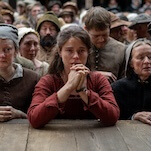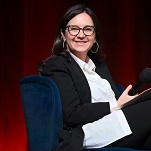Black In Latin America debuts tonight on PBS at 8 p.m. Eastern. You should check local listings.
Talking about race in any kind of mass media is almost impossible, once you move beyond platitudes like “Martin Luther King Jr. is good!” and “slavery is bad!” Racial conceptions and perceptions of all kinds are so deeply interwoven into our society that what seems an innocuous statement can cause great offense, or seemingly outlandish claims in one venue are perfectly normal in the next. Thus, any piece hinging on race, as Black In Latin America clearly does, has to walk many fine lines between advocacy and history, for example, or between watering down the message in order to cast a wide net or pursuing an already-interested niche audience.
To its credit, Black In Latin America manages to succeed in walking most of those fine lines. Its focus on Latin America, instead of the United States of America, diffuses and defuses some of the most incendiary components of the race discussion. In the opening episode, focused on the divided island of Hispanola and its two nations of Haiti and the Dominican Republic, the extremely different tracks of racial construction and identity in both nations are implicitly held up as mirrors for the American audience. By showing how racial identity is socially constructed elsewhere, Black in Latin America opens an intellectual door towards the consideration of racial identity as socially constructed everywhere, including the home audience in America.
But this is not some academic and ideological screed which somehow made its way to the small screen. The narrator is renowned popular historian and Harvard professor Henry Louis Gates, Jr., and the documentary exhibits the deft touch of a writer who is used to making difficult concepts easy to understand. This episode of Black In Latin America is, first and foremost, a history of the island, both political and cultural. Although both nations on the island are filled mostly with people of African descent, they have very different concepts of African heritage and black skin. Simply—and very generally—put, the Dominicans have constructed an identity that rejects blackness, while the Haitians celebrate it.
One of the most interesting formal decisions made by Black In Latin America is to put the history of the Dominican Republic in the first half of the episode, with Haiti coming after. Haiti is more commonly found in the news here, thanks to American involvement in coups and counter-coups of the past few decades, in addition to the terrible earthquake of 2010. It also has the more colorful history, thanks to its successful slave revolt and history of resistance to colonial powers. By putting the Dominicans first, the documentary makes their less overtly dramatic story of identity construction at the same level as the Haitian history.
It helps that the nation's story is fascinating. Its capital, Santo Domingo, was the first Spanish colonial capital in the New World, and the Dominicans take great pride in that. Their conversion from a sugar-based economy to a livestock-based economy helped to demolish the system of chattel slavery, while also slowly pushing the white, colonial Spaniards out of the country. After Haiti’s slave rebellion and brief occupation of the Dominican side of the island, the new Dominican Republic built its culture on opposition to Haiti’s, including Haiti’s blackness. The point is hammered home in arguably the documentary’s best scene, when Gates and a Dominican academic visit a shrine to the nation’s freedom. There, they find four statues of founding fathers: Washington, Jefferson, and Hamilton, in addition to Juan Pablo Duarte, considered the architect of Dominican independence. Duarte has a white statue, both in terms of the marble from which it is made and the features he has been given, as Gates notes. It is not an isolated example, as a trip to the national history museum demonstrates, when Gates is given a guidebook from the ‘50s showing, for example, an all-white collection of beauties in bathing suits.
Gates is an affable host through the entire journey, cutting a somewhat dashing figure with his trimmed beard, walking cane, and easy smile. He is perhaps too active of a listener, making some of the conversations seem staged (perhaps they were), and his voice seems oddly cheerful at times, making some statements about horrific parts of history seem incongruous with his intonation. (His recent controversy, when some tried to portray him as the archetypal radical, angry black man, seems almost inconceivable compared to the man on camera.)
But his historical input is valuable, even necessary, when it comes to trying to understand some of the darker historical chapters of Haitian history. After the success of the slave revolt, he attempts to contextualize the Haitian leader’s attempt to kill all Frenchman remaining in the country, just as he does their dismantling of the economic infrastructure which had made the colony so rich. Likewise, he explains why the major American powers of the time—France, Britain, and the United States—were dead set against Haiti’s success. He does hide his opinion in these cases, but as a historian, he places context and rationale above snap moral judgments.
Black In Latin America feels a little bit unpolished at times. A segment on vodou in Haitian life is important historically, and Gates does his best to debunk the myths surrounding the religion. But the visuals undermine this to some degree, as, for example, his initial foray into a vodou gathering shows an apparently exhausted woman reclining and smoking a cigarette and not looking religious at all, and pictures of ecstatic dancing, not common in American religions, are not described as such. The narration is also redundant at times, with Gates repeating certain specific phrases, such as how resilient the Haitians are, an unnecessary amount. The documentary is also a little bit light, as would be expected with a 50-minute running time and the complexity of the subject matter. That said, Black In Latin America manages to convey that complexity and tell fascinating history and deserves credit for doing so.







































